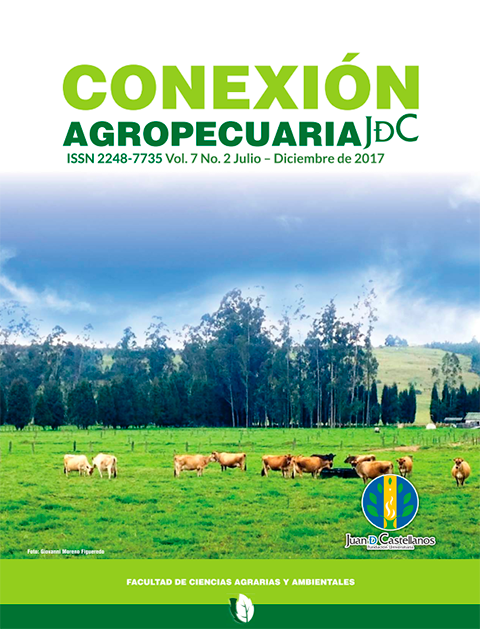Keywords:
mashua, incubation, yogurt, physicochemical characteristics, concentrateAbstract
Mashua (Tropaeolum tuberosum) are Andean and indigenous tubers grown in Colombia, Peru, Bolivia, Paraguay, Brazil, Ecuador, and Venezuela, which are characterized by their nutritional value. However, their consumption and popularity have declined. Therefore, the objective is to diversify the use and utilization of the edible parts of the species. Yogurt was made by using mashua concentrate in three different combinations (3 %, 7 %, and 10 %). The pH, titratable acidity, syneresis, and viscosity were evaluated during the yogurt incubation period. The results indicated that the final titratable acidity was 0.94, 1.26 and 1.35 % lactic acid for treatments 1, 2 and 3, respectively. The pH values for the three treatments ranged from 4.7 to 4.3. The syneresis showed results of 51 %. The protein data indicated that a higher mashua concentration led to a higher percentage of protein. Finally, the rheological study allowed to identify pseudoplastic characteristics of yogurt for the three treatments. The study allowed to determine the viability of using cube in the elaboration of yogurt
Downloads
References
AOAC. 2005. “Official Methods of Analysis” Association of Official and Analytical Chemists Washington DC (12 Ed.).
BELTRÁN, A. & MERA, J. 2014. Elaboración del tubérculo Mashua (Tropaeolum tuberosum) troceada en miel y determinación de la capacidad antioxidante. Tesis Universidad de Guayaquil.
CÁRDENAS, A., ALVITES, H., VALLADARES, G., OBREGÓN, J. & VASQUÉZ, V. 2013. Optimización mediante diseño de mezclas de sinéresis y textura sensorial de yogurt natural batido utilizando tres tipos de hidrocoloides. Revista Agroindustrial Science 3: 35-40.
CASTILLO, D., SÁNCHEZ, J. & CASTRO, P. 2012. Efecto de la concentración de sólidos totales de la leche entera y tipo de cultivo comercial en las características reológicas del yogurt natural tipo batido. Revista Agroindustrial Science 2: 173-180.
CÓRDOVA, J., GONZALES, U. & CERRÓN, L. 2018. Physicochemical and sensory properties of yogurt as affected by the incorporation of jumbo squid (Dosidicus gigas) poder. LWT - Food Science and Technology 93: 506-510.
CHIRINOS, R., CAMPOS, D., WARNIER, M., PEDRESCHI, R., REES, J. & LARONDELLE, Y. 2008. Antioxidant properties of mashua (Tropaeolum tuberosum) phenolic extracts against using biological in vitro assays. Food Chemistry 111: 98-105.
CHABUR, M. 2012. Evaluación del efecto de liofilizado de cubios (Tropaeolum tuberosum) en las poblaciones microbianas de suelo como estrategia de manejo de rhizoctoniasis en cultivo de papa. Universidad Nacional de Colombia. Tesis. Colombia.
ENSIN. 2015. Gobierno presenta Encuesta Nacional de Situación Nutricional de Colombia. Julio 12 de 2018. Recuperadao de http:// www.icbf.gov.co/portal/page/portal/Descargas1/Prensa1/Comunicado%2021-nov.pdf
FAROOQ, K. & HAQUE, Z. 1992. Effect of sugar esters on the textural properties of nonfat low-calorie yogurt. Journal Dairy of Science 75(10): 2676-2680.
FU, R., LI, J., ZHANG, T., ZHU, T., CHENG, R., WANG, S. & ZHANG, J. 2018. Salecan stabilizes the microstructure and improves the rheological performance of yogurt. Food Hydrocolloids 81:474-480.
GOLDNER, M., PÉREZ, O., PILOSOF, A & ARMADA, M. 2012. Comparative study of sensory and instrumental characteristics of texture and color of boiled under-exploteid Andean tubers. Fodd Science and Technology 47: 83-90.
HASSAN, A. & AMJAD, I. 2010. Nutritional evaluation of yoghurt prepared by different starter cultures and their physiochemical analysis during storage. African Journal of Biotechnology 9: 2913-2917.
ICONTEC - Instituto Colombiano de Normas Técnicas y Certificación. 2005. NTC 805. Productos lácteos. Leches fermentadas.
INSTITUTO GEOGRÁFICO AGUSTÍN CODAZZI. 2017. Recuperado de http://www.igac.gov.co/wps/portal/igac/raiz/iniciohome/MapasdeColombia/
KAILASAPATHY, K. 2006. Survival of free and encapsulated probiotic bacteria and their effect on the sensory properties of yoghurt. LWT 39:1221-1227.
MOREIRA, T., TRANSFELD, A. & FAGUNDES, C. 2017. Elaboration of yogurt with reduced level of lactose added of carob (Ceratonia siliqua L.). Food Science and Technology 76: 326-329.
PARRA, R., MARTÍNEZ, C. & ESPINOSA, J. 2011. Comportamiento fisicoquímico de stevia, fructosa, dextrosa y lactosa como endulzantes a diferentes concentraciones durante el tiempo de incubación en la elaboración de yogurt entero. Bistúa: Revista de la Facultad de Ciencias Básicas 9: 15-20.
PARRA, R. 2012. Yogurt en la salud humana. Revista lasallista de investigación 9: 160-175.
PARRA, R. (2013). Efecto del té verde (camellia sinensis) en las características fisicoquímicas, microbiológicas, proximales y sensoriales de yogur durante el almacenamiento bajo refrigeración. Revista @limentech Ciencia y Tecnología Alimentaria 11(1): 56-64.
PARRA. 2015. Uso de rubas (Ullucus Tuberosus) en la elaboración y caracterización de yogur. Revista Temas Agrarios 20 (1): 91-102.
PARRA, R., BARRERA, L. & ROJAS, D. 2015. Evaluación de la adición de avena, mango y estevia en un yogur elaborado a partir de una mezcla de leche semidescremada de cabra y de vaca, Revista Corpoica 16(2): 167-179.
PELAES, A., AKIE, P., NAOMI, L., GOMES, S., ALVES, B., VATARU, C. & MATUMOTO, P. 2015. Microbiological, functional and rheological properties of low fat yogurt supplemented with Pleurotus ostreatus aqueous extract. Food Science and Technology 64:1028-1035.
RAMÍREZ, M. & VÉLEZ, J. 2013. Physicochemical, rheological and stability characterization of a caramel flavored yogurt. Food Science and Technology 51: 233-241.
SILVA, B., RESENDE, S., SOUZA, A., SILVA, M., PLÁCIDO, G. & CALIARI, M. 2014. Physicochemical, rheological and stability characterization of a caramel flavored Yogurt. African Journal Biotechnology 13(37): 3797-3804.
ZARE, F., BOYE, J. & ORSAT, V. 2011. Microbial, physical and sensory properties of yogurt supplemented with lentil flour. Food Research International 44: 2482-2488.





